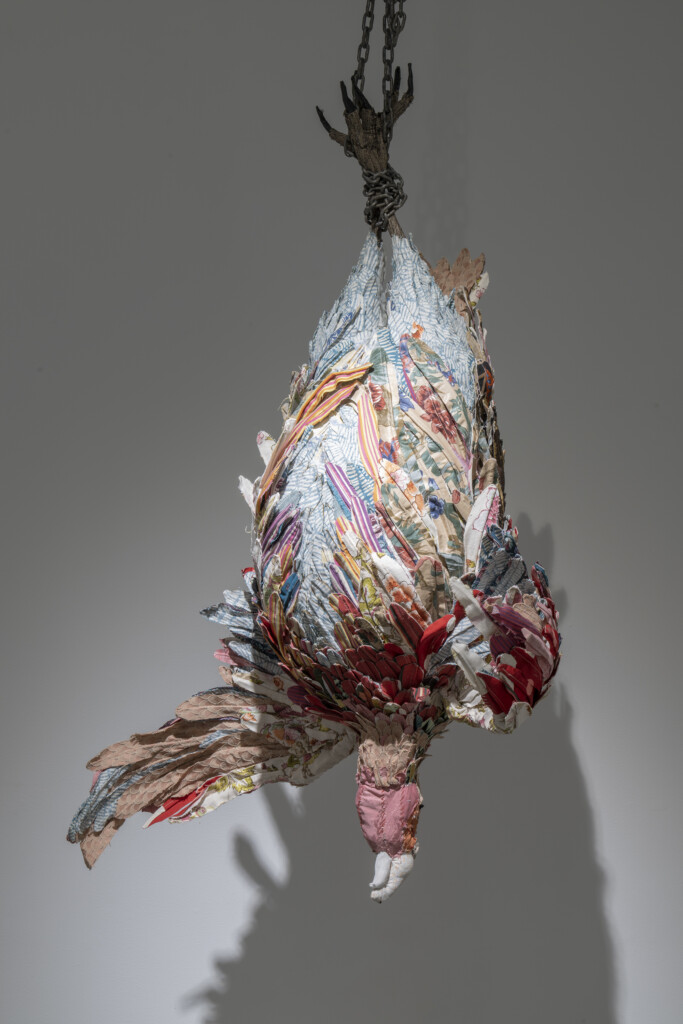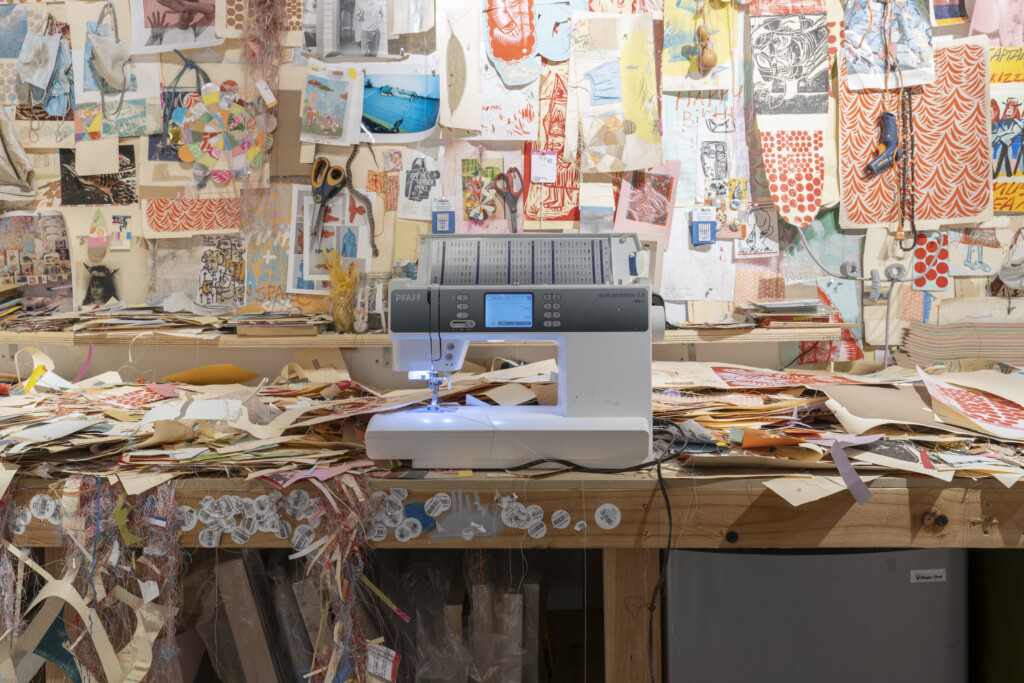EDITOR’S NOTE: This feature also is published in Spanish here. Translation is courtesy of Mark Alvarez, a local immigration attorney.
Two ongoing exhibitions at the Utah Museum of Contemporary Art highlight the expanding perceptions of gallery presentations and visibility in visual arts: Beyond the Margins: An Exploration of Latina Art and Identity and Thomas Campbell: Making stuff to express stuff, To share stuff, So others can feel or wanna make stuff, Hopefully.
Beyond the Margins: An Exploration of Latina Art and Identity
Elegantly curated in its compact but potent spectrum of cultural expression, the exhibition Beyond the Margins: An Exploration of Latina Art and Identity presents four artists who are solidly bonded to their respective heritage legacies while growing and composing identities that cross and integrate many linguistic and cultural boundaries.

Collectively, the four artists – who identify, respectively, as Puerto Rican, Mexican-American, Argentinian-American and Afro-Dominican-New York – demonstrate most effectively that cultural orientations are not just hybrid but also are built with layers atop one another.
The exhibition was curated by María del Mar González-González, assistant professor of global modern and contemporary art history at Weber State University. In an interview with The Utah Review, she explains, “Since graduate school, I have been researching the concept of borders and being marginalized and the experiences of being erased and left in silence,” she says. “I have been thinking about who gets to tell the story as well as what story is being told.” González-González, who is from Puerto Rico, remembers that the history of her homeland was not widely taught, an experience that has been significant for her personally as well as for her scholarly work.
Just as problematic are those instances where curatorial responsibilities for a Latin American art gallery sometimes have fallen to a curator trained in European art or in a discipline that does not engage relevant heritage foundations. Thus, moving beyond the margins, as advised in this show, erases the conventions and stereotypes of what we typically have seen conflated in other Latin American art exhibitions — where thematic ideas, color palettes, stylistic fluences, and attention to specific subject matter usually have been contextualized in conveniently tidy classifications of genre and aesthetic.

In curating the UMOCA show, González-González focused on avant-garde and conceptual expressions that do not fit a neat narrative. As further enlightenment, she mentions the example of Nigerian-British artist Yinka Shonibare, who sometimes has been criticized as not being African enough in his art. In an interview last year with The Guardian, Shonibare talked about growing up in Lagos, and how he cultivated the use of brightly colored Ankara textiles, especially in his installation art. The fabric he uses is Dutch wax-printed cotton, which he explains is a “way of expressing the dual identity of a modern African like myself, to understand that the identity of a post-colonial African has been touched by Africa’s contact with the rest of the world.”
This sentiment finds its own enlightened translation in Beyond the Margins. In the triptych Impossible Bouquets: After Jan van Huysum, Salt Lake City and Mexican-American artist Nancy Rivera makes a compelling artistic statement in archival inkjet prints, depicting a carefully composed arrangement of flowers that could never have bloomed simultaneously, because of climates and the fact that they came from geographical regions which experience different seasons at different times of the year. Therefore, it took the original Dutch artist up to two years to realize the paintings.
Rivera’s photographs reproduce the original paintings by featuring the arrangements of artificial flowers. And, as González-González notes, silk flowers are a common sight in many Latino households, which adds Rivera’s heritage signature to the cultural foundation of the work. Like Shinobare’s work with Dutch wax-cotton fabrics, Rivera deftly upends the conventional cultural perceptions, showing how the artificial construct has always supported various illusions.

Courtesy of the artist and Slag Gallery
There also is a commanding translation of Dutch still life in the soft sculpture Every Color in the Rainbow by Argentinian-American artist Tamara Kostianovsky, a 2021 piece created from discarded textiles, chain, hook and motor (which, incidentally, has been well hidden in the ceiling).
Kostianovksy, who often upcycles clothes and fabrics from her wardrobe, creates sculptures that bluntly subvert the sanitized external appearances of body and life in society and community. She excels at uncovering the proverbial process of how sausage is actually made behind the scenes. Discolored underwear becomes ligaments, stained cloths become feathers and frayed sweaters become ways of representing animal fat and flesh. In 2021, at an exhibition at Ogden Contemporary Arts, another soft sculpture by Kostianovksy, Roadkill, was presented, fashioned to resemble a bloodied leg of a freshly slaughtered cow. The symbolism in her work has multiple meanings that eventually converge at some point: crude consumerism, political violence where maiming and body desecration occur, and disregard for one’s rights to control their body.
Kostianovsky, a Brooklyn resident, has gained an international reputation for her sculptures, which have an unmistakably natural quality of effect and appearance. She has at least eight exhibitions scheduled this year, including a solo show Mesmerizing Flesh at Ogden Contemporary Arts, which runs through April 16, as well as forthcoming shows in Germany and France.
A similar counterpoint of ugliness and beauty centers the astounding intricate lace-like paper cuts in Frances Gallardo’s Carmela. The exceptionally delicate hand-cut paper collage is in four layers and highlights the brown muddy tones found in soil and beach erosion and landslides sparked by the immense rains of hurricanes. Gallardo has created a series of landscapes recreated from archived satellite images of hurricanes. While she composes each work to reflect the respective storm data, she also expands on the theme of connecting with traditions that mark time and era.

The work of Gallardo, who is from Puerto Rico, epitomizes the dominance of the hurricane event in the history of her homeland. She also is one of the artists featured in a current show at the Whitney Art Museum of American Art, the first show of contemporary Puerto Rican art presented in a major U.S. museum in nearly half a century. Titled no existe un mundo poshuracán: Puerto Rican Art in the Wake of Hurricane Maria, the exhibit highlights artists who explore the aftermath of Hurricane Maria, which struck the island in 2017, and the broader sociological, physical and cultural impacts of the storm.
Saso and Yaissa comprise the excellent diptych by Yelaine Rodriguez, an Afro-Dominican-York artist who lives in New York City, representing two portraits from the Afro-Sacred Familia series. The work is composed of analog photography digitally printed on fabric, and incorporating elements of ribbon, cowrie shells, and beads in the multimedia presentation. The diptych comes from the series Afro-Sagrada Familia (Afro-Sacred Family), in part a tribute to La Sagrada Família, the monumental Roman Catholic Minor basilica in Barcelona, which was started in the late 19th century by architect Antoni Gaudi.

Utah Museum of Contemporary Art, Jan. 20–March 4, 2023. Photo by Zachary Norman, UMOCA.
Rodriguez amplifies the African diaspora encompassed in Quisqueya, representing modern-day Dominican Republic. In part, the portraits echo those of religious figures and saints familiar to Catholic representations in the visual arts. But, these portraits also restore the essential visibility of Afro-Syncretic religions such as Santeria and Vodou. The models are Afro-Dominican performers and creative producers and they wear handwoven clothing and the objects associated with the Orixá (o-ree-sha), which are nature deities found in West African and African diasporic culture. The objects are placed in front of the portraits, just as statuettes of Catholic saints would be placed in front of paintings or prints, as objects of veneration.
The overall remarkable aspect of building a show in the Projects Gallery, the smallest exhibition space in UMOCA, is how Beyond the Margins achieves an eminently satisfying clear, comprehensive statement, with an outstanding sampling of just seven art pieces from four artists.
González-González and Rivera will conduct a tour and conversation of the show in Spanish on Feb. 25 at 1 p.m.
Thomas Campbell: Making stuff to express stuff, To share stuff, So others can feel or wanna make stuff, Hopefully
In UMOCA’s Street Gallery, the show with the long yet perfect encapsulation of its meaning — Thomas Campbell: Making stuff to express stuff, To share stuff, So others can feel or wanna make stuff, Hopefully— is a gobsmacking example of one of the most important American pop art movements in recent decades. Around the country, there are numerous communities — the Salt Lake City metropolitan area included — where skaters, surfers, snowboarders, DJs, emcees, hip-hop artists, graphic artists, poets, writers, illustrators, animation artists, sculptors, filmmakers, etc., have propelled a fascinating independent enterprise of do-it-yourself creative production. Some are academically taught and professionally trained but many also are self taught who just happen to find a creative outlet in any place and in any activity. They also have built up networks where the critical mass eventually percolates from the underground to wider mainstream visibility. Many of these artists thrive on being prodigious in their work, often working on multiple projects simultaneously and constantly exploring new media and mixing media forms.
At 54, Thomas Campbell, whose artistic base is in Bonny Doon, California, is known around the world and has a huge following. Everything about his work exudes from a freestyle approach, as he transitions effortlessly from printmaking to photography and collage and to ceramics and bronze along with music, books, filmmaking and commercial collaborations. One of the most attractive dynamics is the appropriate embrace of wabi-sabi, which propels the kinetic spontaneity of pop art culture at its best.

Campbell’s show is unique for how it centers on the creative process, which informs why DIY creative entrepreneurship is as durable as it can be ephemeral in its appeal. A literal recreation of part of his California studio is the cornerstone of the exhibition. For those who espouse the virtues of a perpetually cluttered workspace or desk, Campbell’s lab will elate the visitor. This includes some of the equipment he uses, such as a sewing machine, ceramic wheel, waterproof housing for underwater filming and linoleum cutter for printmaking.
His resourceful purposing of materials is laudable (for example, sections of manilla folders become canvases, along with materials for collages and sculptures). Some of his work is produced quickly. Much of it was created during a frenetic surge, as the exhibition was being installed. But, he also has a capacity for meticulous technique in his work, as evidenced in several pieces. There is a marvelous time-lapse video of the artist in action. It adds the context to justifying his distinction as an organic artist who can respond extemporaneously to the creative moment. He maneuvers constantly between abstract and representational elements in the making of his art.

Campbell is well known to many DIY creative communities. It was no small accomplishment for UMOCA to land an exhibition of his work. His solo shows have been installed in New York, Paris, Tokyo, Denmark, The Netherlands, San Francisco, Los Angeles and Morocco. In 1999, he completed his first feature length surfing film, The Seedling, and in 2004 released his second, Sprout and in 2009 he completed The Present. While he has been co-owner of various media enterprises, he established Um Yeah Arts a decade ago, which is known for producing books, music and films.

2 thoughts on “Two exhibitions at Utah Museum of Contemporary Art highlight creative entrepreneurship in its broadest scope, composing Latina art in vast, compelling spaces”